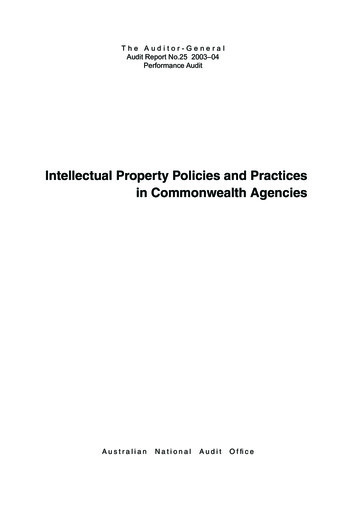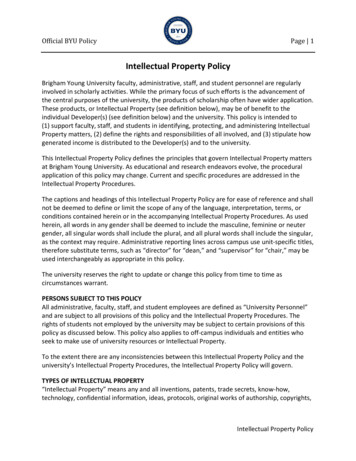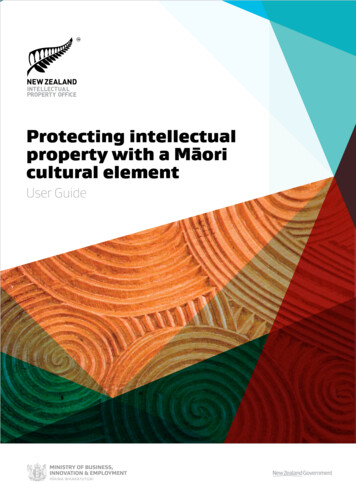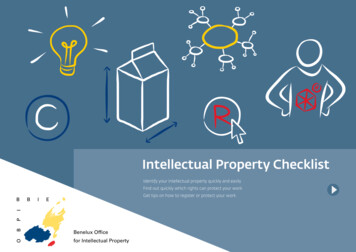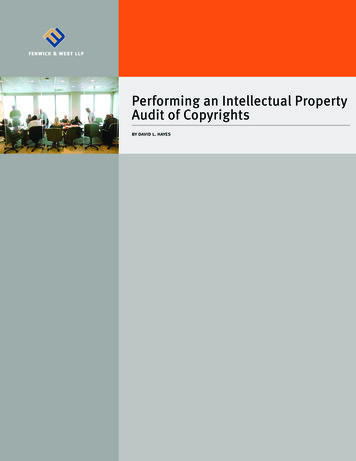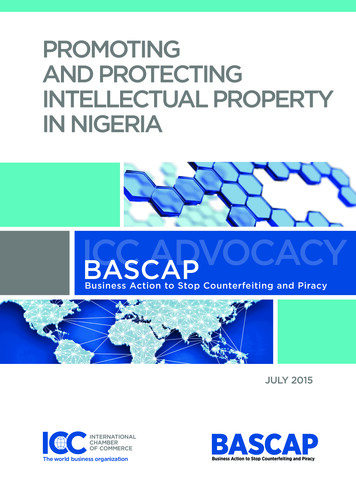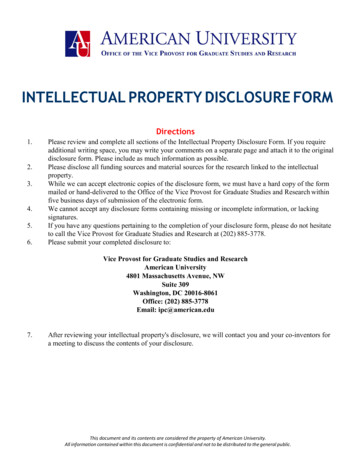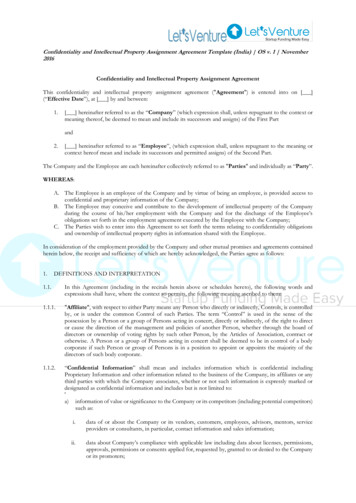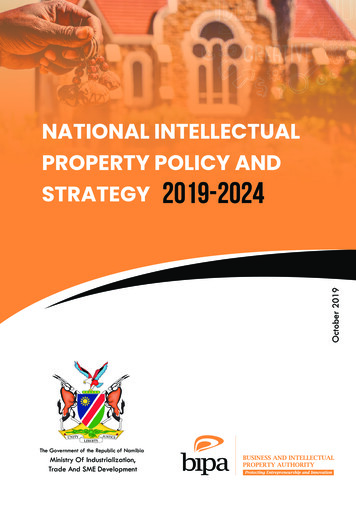
Transcription
October 2019NATIONAL INTELLECTUALPROPERTY POLICY ANDSTRATEGY 2019-2024The Government of the Republic of NamibiaMinistry Of Industrialization,Trade And SME Development
2IP POLICY - 2019 - 2024AcknowledgementThe Government of the Republic of Namibia would like to express its thanksand gratitude to the World Intellectual Property Organization (WIPO) forsupporting the Intellectual Property (IP) needs assessment (IP audit) andthe development of this National Intellectual Property Policy and Strategy(NIPPS); Consultants and the members of the IP task force for the tireless effortand valuable contribution towards the Policy framework.The Government would like to thank the Business and Intellectual PropertyAuthority (BIPA) and staff members, for their contribution, their involvement inthe coordination of the programs leading to the drafting of the NIPPS andensuring that the Policy reflects a true national consensus.The Government is extremely grateful to all the stakeholders for havingavailed time and willingness to share information and views on all the aspectsof IP. Without the generous support and cooperation of all Namibians, thedrafting of the NIPPS would not have been successfully completed.Thank you.Steve Katjiuanjo (Amb)Executive DirectorMinistry of Industrialization, Trade and SME Development
TABLE OF CONTENTSACKNOWLEDGEMENT 2FOREWORD 4ABBREVIATIONS 5GLOSSARY OF CONCEPTS, TERMS AND EXPRESSIONS6EXECUTIVE SUMMARY 8PART A 101. INTRODUCTION 112. BACKGROUND 133. RATIONALE 184. ALIGNMENT 195. POLICY GUIDING PRINCIPLES 20PART B 216. POLICY DIRECTION 226.1 Vision 226.2 Mission 226.3 Goals 227. POLICY OBJECTIVES AND STRATEGIES23PART C 328. IMPLEMENTATION FRAMEWORK 338.1 Institutional Arrangement 338.2 Legal and regulatory Arrangements338.3 Resource Mobilization 348.4 Monitoring and Evaluation Framework and Reporting358.5 Advocacy and Dissemination (Communication Strategy)36PART D 379. CONCLUSION 38Annex-I Five Years Action Plan for Implementation of NIPPS38Annex II - Bibliography 49IP POLICY - 2019 - 20243
4IP POLICY - 2019 - 2024ForewordIntellectual Property (IP) serves as an effective policy tool in unlocking local creative,inventive and innovative potential, stimulating the transfer and use of technologiesand creative works, encouraging fair competition thereby promoting the creation ofwealth and fostering national social, cultural and economic development. In order forIP to play this role effectively, there is need to put in place a policy framework.The Government of the Republic of Namibia is cognizant of the fact that the absenceof a National Intellectual Property Policy and Strategy (NIPPS) in Namibia hasfundamentally deprived the country of a convenient framework that would supportdevelopmental goals and objectives of the country.The drafting of this Policy and Strategy, therefore, is a timely development that mustbe braced by all Namibians in both the public and private sectors in order for thecountry to ensure effective use of IP as a tool for development and improvement ofthe welfare of Namibians.This NIPPS is designed to ensure IP is fully integrated into the national and sectoraldevelopment polices and strategies; support and promote the generation, protectionand commercialization of IP assets, stimulate transfer of technology, ensure adequateenforcement of intellectual Property right, increase IP awareness, strengthen thecreative industry and promote use of intellectual property in areas where Namibiahas comparative and competitive advantages.Effective implementation of the NIPPS will enable the use of IP in meaningfullysupporting VISION 2030 and meeting the goals of national and sectoral developmentPolicies, Strategies and Plans.Hon. Tjekero Tweya, MPMinisterMinistry of Industrialization,Trade and Small and Medium Enterprises Development.
ABBREVIATIONSABS - Access and Benefit SharingARDI - Access to Research for Development and InnovationARIPO - African Regional Intellectual Property OrganizationASPI - Access to Scientific Publication and InformationBIPA - Business and Intellectual Property AuthorityCMOs - Collective Management SocietyGDP - Gross Domestic ProductGRs - Genetic ResourcesHLIs - Higher learning institutionsHPP - Harambee Prosperity PlanIP - Intellectual PropertyIPAs - Intellectual Property AssetsIPRs - Intellectual Property RightsIPS - Intellectual Property SystemMAWF- Ministry of Agriculture Water and ForestryMET- Ministry of Environment and TourismMHETI - Ministry of Higher Education, Training and InnovationMICT - Ministry of Information Communication TechnologiesMIRC - Ministry of International Relations and CooperationMITSMED - Ministry of Industrialization, Trade and Small and Medium Enterprises DevelopmentMOU - Memorandum of UnderstandingNASCAM - Namibian Society of Composers and AuthorsNCRST - National Commission on Research, Science & TechnologyNIPPS - National intellectual Property Policy and StrategyNCCI - Namibian Chamber of Commerce and IndustryNUST - Namibia University of Science and TechnologyR&D - Research and DevelopmentSMEs - Small and medium sized enterprisesTCEs - Traditional Cultural ExpressionsTISCs - Technology and Innovation Support CentersTK - Traditional KnowledgeTTO - Technology Transfer OfficeUNAM - University of NamibiaWCO - World Customs OrganizationWIPO - World Intellectual Property OrganizationIP POLICY - 2019 - 20245
6IP POLICY - 2019 - 2024GLOSSARY OF CONCEPTS, TERMS AND EXPRESSIONSIn this NIPPS, unless the context otherwise requires:1. “Creative industries”, which are also referred to as copyright based or cultural industries,relate to those industries that combine the creation, production and commercialization ofcontents, which are typically protected by copyright and related rights and take the form ofgoods or services such as visual arts, dance, performing arts, crafts, music, film and video, andliterature.2. “Expressions of Folklore or Traditional Cultural Expressions”- are any forms, whethertangible or intangible, in which traditional culture and knowledge are expressed, appear orare manifested, and comprise the following forms of expressions or combinations thereof:(a)Verbal expressions, such as but not limited to stories, epics, legends, poetry, riddles andother narratives; words, signs, names, and symbols;(b)Musical expressions, such as but not limited to songs and instrumental music;(c)Expressions by movement, such as, but not limited to dances, plays, rituals and otherperformances; whether or not reduced to a material form; and(d)Tangible expressions, such as productions of art, in particular, drawings, designs,paintings (including body-painting), carvings, sculptures, pottery, terracotta, mosaic,woodwork, metal ware, jewelry, basketry, needlework, textiles, glassware, carpets,costumes; handicrafts; musical instruments; and architectural forms.3. “International legal Instruments” means agreements, conventions, treaties and protocolsconcluded amongst states at regional or international level.4. “Intellectual Property”- refers to creations of the intellect which has moral and/or commercialvalue. IP includes inventions, literary and artistic works and symbols, names and images usedin trade.5. “Intellectual Property Rights”- refers to enforceable rights over creations of the mind, whichgives the creator exclusive rights to exploit and benefit from their creation, and prevent othersfrom making unauthorized use of their property for a limited period, in exchange of thedisclosure of the creative work.
6. “Stakeholders” include intellectual property right holders, researchers, authors, artists, inventors,academic and research institutions, traditional knowledge holders, local communities, industryand business establishments and policy makers.7. “Technological information” means solutions to technological problems contained in patentdocuments or scientific and technological information that may be accessed using WIPO, ARDIand ASPI programs.8. “Traditional knowledge”-means any knowledge originating from a local or traditionalcommunity that is the result of intellectual activity and insight in a traditional context, includingknow-how, skills, innovations, practices and learning, where the knowledge is embodied in thetraditional lifestyle of a community, or contained in the codified knowledge systems passed onfrom one generation to another. The term shall not be limited to a specific technical field, andmay include agricultural, environmental or medical knowledge, and knowledge associated withgenetic resources.IP POLICY - 2019 - 20247
8IP POLICY - 2019 - 2024Executive SUMMARYThe Intellectual Property (IP) Policy establishes the framework conducive for innovation andcompetitiveness through IP generation, protection and commercialization. It defines the parametersof the use of IP as a strategic catalyst to accelerate transformational growth at home. The Policysets Namibia’s vision for IP, identifies objectives and key strategies and establishes an institutionalframework to serve as the coordinating body in IP related policy and strategic matters.Creativity and innovation is common to all men, unlike natural resources which are found in certaincountries and regions. Therefore, as faithful stewards, we have an obligation to ensure that allintellectual properties rights are recognized, protected and valued.Given the cross-cutting nature and scope of, the Policy responds to the linkages between IP andother areas in particular, industrialization, trade, investment, innovation, science, technology,agriculture, education traditional knowledge and genetic resources. It addresses the relationshipof IP to communication polices, universities & research and development institutions & SMEs.The Policy provides a framework which maintains a balance between protection of IP rights andsafeguarding against market abuse; promote and reward innovation whilst ensuring access toaffordable quality medicine; create incentives for industrial innovation whilst leaving room forongoing progress in research and development; effective and balanced enforcement strategiesthrough education, empowerment and coordination; protect all IP rights and safeguard publicinterest; uphold and promote the value of knowledge and technology transfer, without underminingprotection and attracts investors while promoting local innovation.Part A of the Policy provides the introductory scene which covers introduction, background,rationale, alignment and guiding principles. It provides the setting and context of the Policy withinthe existing national frameworks.In the words of his Excellency, the President: “The war against poverty and the quest for economicemancipation must be a multifaceted war which we will fight on many fronts, using a myriad ofmethods at our disposal.”The development of Intellectual Property Policy & Strategy is yet another intentional initiativetowards the prosperity of the Namibian house. The Policy creates a framework conducive to unlockthe potential of IP as a tool towards poverty eradication. The Policy sets the framework to ensureeffective use of IP for transformational growth at home.
PART B covers the policy direction. This section provides vision, mission, goals and objectives of thePolicy. It defines the ideal role of IP as a development tool in Namibia, identifies the mechanismsthough which the vision can be realized and provides the key milestones necessary to achieve thevision. The section also identifies fourteen objectives, accompanied by various strategies for eachobjective, to be implemented during the lifespan of the Policy. These are critical programs andactivities necessary for the effective implementation of the Policy.Dynamic and comprehensive intellectual property regime requires a responsive and effective legaland institutional framework, with adequate resources, an effective monitoring and evaluation anda communication strategy.Therefore, Part C provides for institutional, legal and regulatory arrangements; resourcesmobilization and monitoring and evaluation framework and reportingThe Policy mandates the Business and Intellectual Property Authority to coordinate all intellectualproperty related matters to ensure policy coherence and implementation of the policy.Part D provides the conclusion.IP POLICY - 2019 - 20249
10IP POLICY - 2019 - 2024PART AINTRODUCTION
1. INTRODUCTION1.1 Namibia has a clear development vision, elaborate national and sectoral development policies,strategies and plans aiming at enhancing socio-economic development, reducing poverty andimproving the living standard of its people. The National Development Vision envisages aprosperous and industrialized Namibia, developed by her human resources, enjoying peace,harmony and political stability by 2030. In order to realize the national development vision,a number of policies, strategies and plans have been developed and are being implemented.The objectives and strategies of each of the above policy instruments can be effectivelysupported with intellectual property.1.2 Intellectual Property (IP) serves as an effective policy tool in unlocking local creative, inventiveand innovative potential, stimulating the transfer and use of technologies and creative works,encouraging fair competition thereby promoting the creation of wealth and fostering nationalsocial, cultural and economic development.1.3 The Government of the Republic of Namibia recognizes that effective use of intellectualproperty, as a tool for development requires clear policy guidance. This Policy is intended toprovide a framework that will facilitate the integration of intellectual property into national andsectoral development policies and strategies, ensure the setting up of development orientedIP systems and foster the use of IP as a tool for development and facilitate the monitoring andevaluation of the impact of the IP system in all these sectors.1.4 The National IP Policy and Strategy (NIPPS), was informed by the following considerations:(a)Development goals articulated in national and sectoral development policies andstrategies as well as commitments to comply with intellectual Property treaties towhich Namibia is party;(b)Addressing gaps and issues identified in the needs assessment study carried out withthe support of the World Intellectual Property Organization in 2016; and(c)Lessons learned from experiences and IP policies of a number of countries includingAustralia, China, Ethiopia, Ghana, India, Japan, Kenya, Mauritius, Moldova,Mozambique, Rwanda, Seychelles, Tanzania, Zambia and Zimbabwe.IP POLICY - 2019 - 202411
12IP POLICY - 2019 - 20241.5 The NIPPS is prepared to meet the needs for using the intellectual property system as atool for meeting development policy goals, encouraging the generation, protection andexploitation of intellectual property assets; providing guidance in the strengthening of theintellectual property legal and institutional framework; linking the national IP system withthe international IP system and maximizing from opportunities offered by its membership toregional and international IP treaties and organizations that administer such treaties.1.6 The following methodologies were used in drafting the NIPPS:(a)Review of relevant literature, development policies, strategies, plans and legislationand commitments of Namibia under IP treaties to which it is a party;(b)Identification of gaps and issues identified in the WIPO needs assessment carriedout in 2016;(c)Reviewing and identifying lessons from experiences of other countries;(d)Enriching the draft with WIPO inputs, members of the IP task force and stakeholders;and(e)Preparing the draft with the template prepared by the National PlanningCommission.1.7 The draft NIPPS was presented, further enriched and validated at a key multi stakeholdersforum, which was organized by WIPO in cooperation with the government of Namibia onFebruary 15 and 16, 2017.
2. BACKGROUND2.1 Namibia has a clear development vision, elaborate national and sectoral developmentpolicies, strategies and plans aiming at enhancing socio-economic development, reducingpoverty and improving the living standard of its people. Vision 2030 envisages a prosperousand industrialized Namibia, developed by her human resources, enjoying peace, harmonyand political stability by 2030. In order to realize the grand development vision, a number ofdevelopment policies, strategies and plans have been developed and are being implemented.The objectives and strategies of each of the above policy instruments can be effectivelysupported with intellectual property. However, little is made to integrate IP in addressingpolicy issues and ensure meaningful use of intellectual property as a tool in meeting policydevelopment objectives. This is partly due to lack of a national IP policy that would enableuse of IP to meet development goals and objectives, ensure policy coherence and provideguidance on:(a)The integration of IP into national and sectoral development policies;(b)The generation and exploitation of IP assets, and the provision of support andpromotion of local creative, inventive and innovative activities as well as the transferof technology;(c)Prevention of the loss of valuable assets and absence of benefit sharing such asthose relating to the misappropriation of traditional or indigenous knowledge andbiological resources;(d)The revision of existing and drafting of new IP laws in compliance with therequirements of international and regional IP agreements to which the country is aparty while exploiting flexibilities in meeting national needs and protecting publicinterest;(e)Maximizing benefits from membership to regional and International IP agreementsand trading arrangements; and(f)Negotiations at bilateral, regional and international levels involving intellectualproperty issues or matters that may affect the generation, protection andcommercialization of IP assets as well as transfer of technology.IP POLICY - 2019 - 202413
14IP POLICY - 2019 - 20242.2 Intellectual property is cross sectoral in nature. IP issues relate to health, agriculture,environment, trade, industry, culture, education, science and technology. Effective use of IPas a tool for development requires greater coordination amongst the key government andprivate bodies in the development and implementation of policies, strategies and laws.However, there is little coordination amongst the relevant stakeholders.2.3 There are research and academic institutions that are involved in the generation and use ofintellectual property assets. However, these institutions do not have institutional IP policy andmanagement units that may guide and support the generation, protection and exploitation ofIP assets as well as provide awards and recognition. As a result, valuable research results thatcould have been patented and exploited were lost due to earlier disclosure. Moreover, thefew inventions that are patented and owned by the University of Namibia and researcherscould not be exploited due to lack of a clear policy direction. Issuance of an institutional IPpolicy may not suffice to address the aforementioned problems and encourage the generationand exploitation of IP assets. There is need to establish an institution that will implement orfacilitate the implementation of the policy.2.4 Namibia has general and specific laws that may help or deal with the protection of intellectualproperty assets. However, review of the existing legal framework reveals that it is inadequateand have a number of shortcomings. These include:(a)Absence of laws that deal with the protection of intellectual property assets suchas traditional knowledge and expressions of folklore, undisclosed information; andabsence of national position on the protection of geographical indications, and newplant varieties;(b)The Copyright and Neighbouring Rights Protection Act, 1994 (Act No. 6 of 1994),which is outdated with numerous shortcomings as it does not provide an enablinglegal framework for the development of creative industries in particular in thedigital environment and address challenges such as those resulting from thedevelopment and widespread use of digital technology and meet the needs ofstakeholders such as protection of traditional cultural expressions and archivematerials; and does not provide for adequate limitations and exceptions to ensureaccess to information for educational and development purposes and access toinformation for people who ar visually impaired;
(c)The Copyrights and Neighbouring Rights Protection Act, 1994 also fails to protectfolkloric work, moral rights and neighbouring rights. It is thus not suited to Namibia’ssocial and economic conditions and aspirations;(d)The repealing of the Trademarks in South West Africa Act, 1973 (Act No. 48 of1973), by the Industrial Property Act, 2012;(e)The amendment of the Merchandise Act, 1941 (Act No. 17 of 194) to comply withthe TRIPS Chapter Three on enforcement;2.5 Namibia is a state party to a number of international and regional intellectual propertyand trade agreements, which may support the use of intellectual property as a tool fordevelopment and enhance competitiveness of local businesses and access to information fordevelopment of all persons and safeguard public interest.2.6 Namibia has delayed in depositing instruments of acceptance, ratification or accession torelevant international treaties and lack of coordinated compliance mechanism with some ofthe existing IP laws with the requirements of international IP treaties to which the country isa party.2.7 Namibia may also need to join other international Intellectual Property Agreements to whichit is signatory or not yet signatory to complement the changes that will be made in existinglegislation addressing challenges and limitations or new laws that may be enacted to meetthe needs of stakeholders. Moreover, there is need to sensitize stakeholders and promote theuse of the international IP system as well as maximize from opportunities offered.2.8 There are IP institutions that are involved in the administration of IP laws; namely:(a)Business and Intellectual Property Authority (BIPA) established by the Business andIntellectual Property Authority Act, 2016 (Act No. 8 of 2016) to streamline thefragmented IP administration;(b)Collective Management Organizations that are involved in managing copyrightand related rights on behalf of their members, collecting and distributing royalties;and(c)IP practitioners that handle IP maters including filing of applications and maintainingIP titles.IP POLICY - 2019 - 202415
16IP POLICY - 2019 - 20242.9 However, the IP institutions have weaknesses and challenges that should be addressed. Theseinclude inadequate capacity, limitation of mandate and lack of a system to determine eligibilityand ensure involvement of professionals that will be engaged in handling IP matters. The IP systemis scarcely used by nationals and residents of Namibia. This is due to a number of factors includinginadequate intellectual property generation, protection and commercialization capacity; and lackor inadequate awareness of intellectual property.2.10 There are laws and institutions dealing with enforcement of intellectual property rights. However,piracy, copying and imitating remains prevalent. This is due to a number of factors including:(a)Inadequate legal remedies;(b)Inadequate knowledge and awareness of IP and the impact of IP infringement bymagistrates and judges;(c)Delay in disposition of court cases, and(d)Inadequate capacity of enforcement agencies.2.11 Efforts have been made by MITSMED, MICT, BIPA and CMOs to raise awareness on intellectualproperty through workshops and events. However, the impact of such endeavors has beeninsignificant as they were not target oriented, limited to few promotional tools such as workshopsand thus lacked continuity. Stakeholders pointed out that the level of awareness of IP amongstright holders or potential users such as businesspersons, researchers, and academic staff of theUniversities, politicians, and the general public is limited.2.12 Namibia has talented people and ethnic groups with diverse cultural resources that could providea solid basis for the development and strengthening of the creative industry. However, the creativeindustry is weak due to a number of factors including:(a)Inadequate recognition of the significance of the creative industry and lack of supportof the sector by the government due to the absence of a study that demonstrates thecontribution and potential contribution of the creative industry to social, cultural andeconomic development;(b)Inaccessibility of finance to exploit creative works and support the creative industry;(c)Lack of incentives to strengthen the emerging industry;(d)Weak associations of right holders, creators and entrepreneurs;(e)Outdated laws that do not protect traditional cultural expressions such as folklore,whichhave been exploited with no return and recognition to local communities; and(f)New technological developments that made reproduction and distribution ofcopyrightable works easy, cheap and fast as well as monitoring infringement andenforcement difficult.
2.13 There are a number of areas where Namibia has comparative advantage and the potentialto boost trade and enhance economic growth using IP. However, little effort is made to use IPin further strengthening this position and maximizing advantages to be gained in this field.2.14 The NIPPS aims at providing guidance that will enable the government to address theaforementioned gaps and ensure effective use of IP as a tool for enhancing social, economic,cultural and technological development as well as improvement of the living standards ofNamibians.IP POLICY - 2019 - 202417
18IP POLICY - 2019 - 20243. RATIONALE3.1 Namibia has clear development policies; strategies and plans, which can be effectivelysupported by intellectual property. However, little effort is made to use the IP system. Themajor reason contributing to this is the absence of a national IP policy and strategy that willguide and promote the utilization of the IP system in a way that will support developmentobjectives. In addition, there are a number of challenges that may impede effective use ofthe IP system in meeting development goals.3.2 The major issues and challenges identified based on the Intellectual Property NeedsAssessment Study carried out in 2016 are the following:(a)Inadequate integration of intellectual property into national and Sectoraldevelopment policies;(b)Inadequate institutional mechanisms to ensure policy coherence and coordination;(c)Lack of or inadequate Institutional IP policy and management framework;(d)Inadequate intellectual property and related legal framework;(e)Inadequate linkage of the National IP system with the international IP system;(f)Inadequate intellectual property administrative frame work & weak Institutionalcapacity;(g)Inadequate generation of IP assets;(h)Inadequate protection of IP assets;(i)Inadequate commercialization of IP Assets and Technology transfer;(j)Insufficient awareness of IP;(k)Inadequate enforcement of IPRs;(l)Lack of guidance on promotion of the creative Industry;(m)Absence of laws and mechanisms for protection of traditional knowledge andtraditional cultural expressions or facilitating implementation of the ARIPOSwakopmund Protocol on the protection of traditional knowledge and expressionsof folklore; address concerns related to misappropriation and sharing of benefitsand provide adequate limitation and exceptions with the aim of promoting accessto copyrighted works for educational purposes and people who are visuallyimpaired;(n)Inadequate use of IP in areas where Namibia has comparative advantage.3.3 This policy is needed to provide guidance to address the aforementioned issues by definingpolicy goals; objectives and strategies; setting institutional arrangements; defining monitoringand evaluation framework and providing a five year implementation plan.
4. ALIGNMENT4.1 This Policy is aligned to the Constitution of the Republic of Namibia, Vision 2030, thecountry’s National Development Plans, the Harambee Prosperity Plan and to the Regionaland International Treaties and Conventions ratified by Namibia.4.2 Since the HPP is designed to augment the existing long-term development plans such asVision 2030 and the National Development Plans, it suffices to stress that the NIPPS strivesto place intellectual property at the center of the achievement of the country’s developmentgoals.4.3 Most importantly, it is noted that Pillars 2 and 4 of the HPP dealing respectively, onEconomic Advancement and Infrastructure Development are important avenues where theuse of intellectual property would serve as an important catalyst for the achievement of theobjectives of the HPP and thereby facilitating the Government’s objectives of eradicatingpoverty, unemployment and inequality.IP POLICY - 2019 - 202419
20IP POLICY - 2019 - 20245. POLICY GUIDING PRINCIPLES(a)The Policy shall provide a framework for effective utilization of IP as an instrumentfor meeting national and sectoral development policies goals and enhancing socioeconomic development.(b)The NIPPS recognizes that all protection measures aimed at various aspects of IP will beeffective and broad enough to cover IPRs aspects that may not perfectly fit in theconventional IP arena such as TK.(c)The NIPPS guides that existing IP laws are revised and new laws are enacted taking intoaccount the goals and objectives of national development plans and sectoral developmentpolicies, the need for a balance between the interest of the right holders and the generalpublic as
Annex-I Five Years Action Plan for Implementation of NIPPS 38 Annex II - Bibliography 49. 4 IP POLICY - 2019 - 2024 . The Policy mandates the Business and Intellectual Property Authority to coordinate all intellectual property related matters to ensure policy coherence and implementation of the policy.
